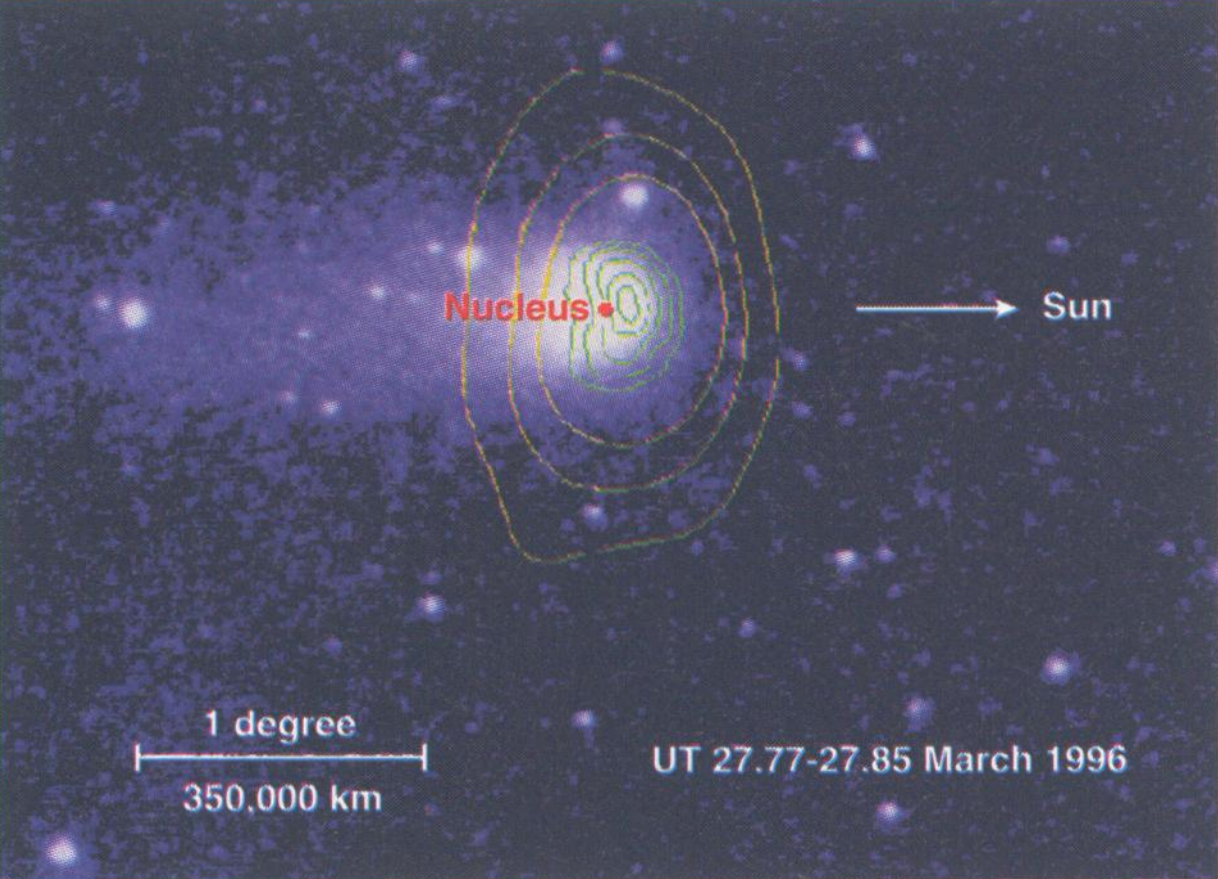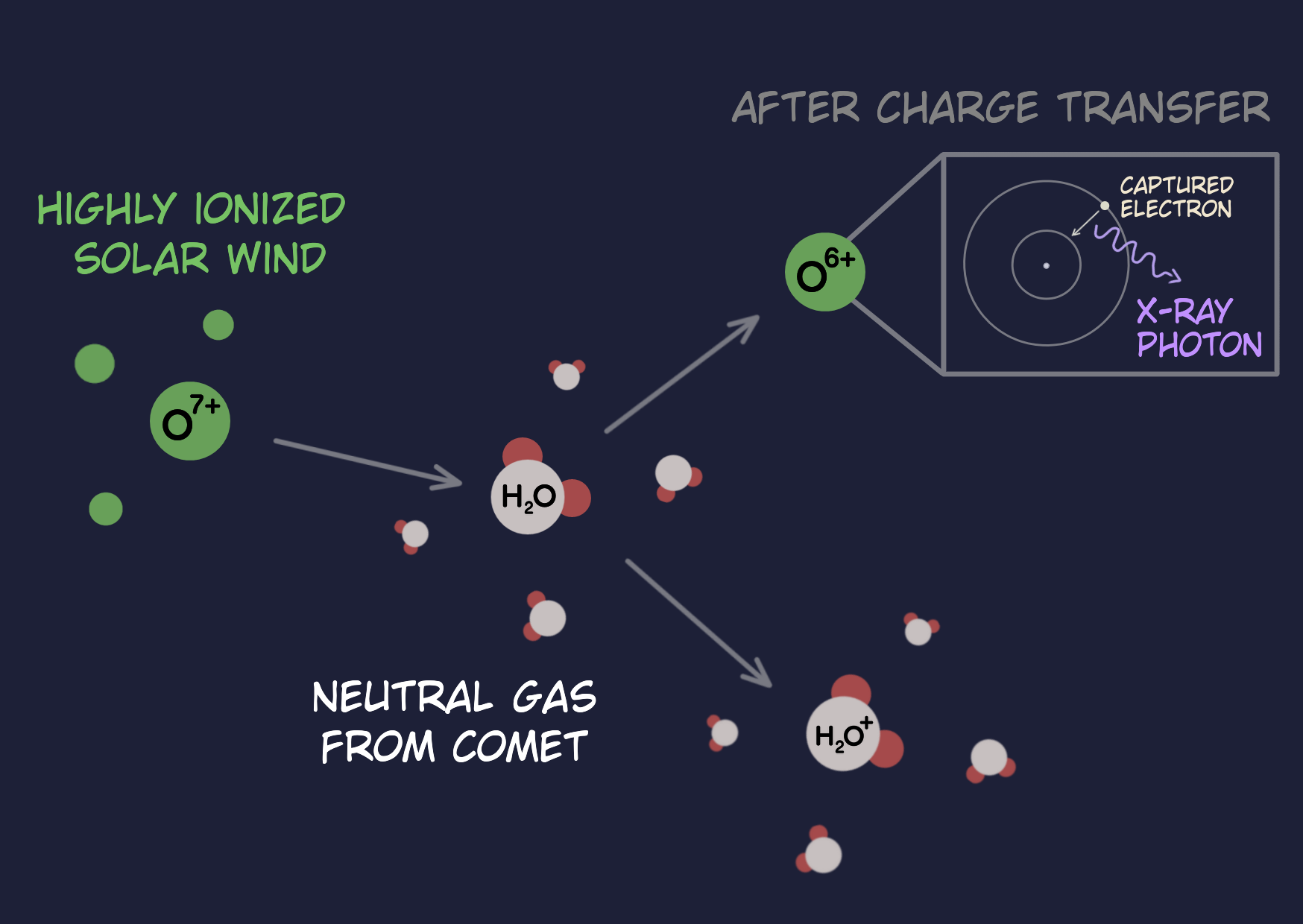X-ray emission from comets
Why we can observe the cold and dirty snowballs in the ultraviolet and X-ray light
Tthe fact that comets can be seen at ultraviolet (UV) and X-ray energies is nothing new. Actually, the X-ray satellite ROSAT observed this emission in 1996, originating from the comet Hyakutake. However, I just recently learned about this and got intrigued, as I've been working on X-ray data a couple of years now, and so far I always had that picture in my mind in which X-rays must be created in a very hot or energetic environment. Given that my main interest of work is in the extragalactic regime, I did not blame myself too much that I did not know this before, but rather did a little digging and thought: maybe you might be curious about X-ray emitting comets, too.
As already mentioned, the first comet to be seen at X-ray light was comet Hyakutake in March 1996. The X-ray satellite, which detected it, was ROSAT, a German satellite, and it did not only observe X-rays, but also extreme ultraviolet emission. Its name stands for 'ROentgen X-ray SATellite'♦. However, ROSAT was not the first X-ray instrument trying to see high energetic emission from comets. Before, a comet called Bradfield 1979X was observed by the Einstein X-ray Observatory, but that observation did not yield a detection.
Comets are cold objects, mostly made from dust and ice, from the outer regions of our solar system and the thought of them producing X-rays, highly energetic radiation, might not sound plausible at first. Whenever we look at the Universe and observe X-rays, most of the time hot plasma and energetic processes are involved. For example, we see X-rays being produced in the solar corona or in the hot gas of supernova remnants. X-ray emission is not necessarily produced through thermal emission (e.g. a plasma, which is so hot that the main part of its total emission radiates away in the UV and X-ray regime). In fact, a certain amount of the X-ray emission in the Universe is coming from particles (e.g. electrons or protons). They emit X-rays when they are decelerated, for example during their interaction with a magnetic field. This is called 'bremsstrahlung'. In order to be influenceable by a magnetic field, particles need to be charged, as it is the case for plasma. In a plasma electrons can move around freely, because, when they gain energy (e.g. from the thermal emission or ionization), they can overcome the energy necessary to leave their bound to the atomic nuclei. Thus, the atoms become ionized and are left with a positive charge. This results in the plasma being composed of both negatively and positively charged particles.

Figure 2. Overlay of an optical image of comet Hyakutake with the contours of the X-ray emission detected by ROSAT. Credit: Lisse et al., 1996, Science, 274, 5285
Could that be the cause for X-ray emission from comets? Well, not really. A comet is made from a mixture of several molecules (e.g., H2O, CO, and CH4) and dust, and while the actual composition might vary from object to object, the ratio of ice and dust is about unity. A comet is often described as a dirty snowball. Comets formed in the outskirts of our solar system and in a way have not changed since our solar system came into existence. This makes them very interesting objects to study if one is interested in the formation of the solar system. Comets that are bound for the inner regions of the solar system form some kind of atmosphere when they get closer to the sun. This atmosphere is called 'coma' and consists of gases, which were once frozen, and are now being evaporated due to the sun heating up the surface of the comet. The outflowing gases drag along the dust from the core, and, since the comet is moving around the sun, create a dust tail, which can be millions of kilometers long. This tail is not emitting light by itself, but reflects the sun light. There also exists a second tail, the so-called ion or plasma tail. The solar UV emission ionizes atoms and molecules from the coma, creating a plasma. Because the solar wind carries highly ionized particles, a magnetic field is embedded in the solar wind that is responsible for tearing the plasma of the comet into a narrow tail, which always points straight away from the sun. This plasma, however, is not responsible for the X-ray emission, as its particles are neither energetic enough to produce X-ray bremsstrahlung, nor is the plasma hot enought to produce thermal X-ray radiation.
So far I've told you a lot about comets and how X-rays in space can be created, but not about the actual X-ray emission of comets, so let me come to that now. There is another way how X-ray photons can be emitted, and it has to do with what can happen within an atom itself. But first back to the X-ray detection.
The ROSAT team was looking at Hyakutake, because they were motivated by the theoretical work from S. Ibadov. He published a paper in 1990 about possible X-ray emission due to high-speed collisions between comet dust and interplanetary dust particles, so a process in which hot plasma is not necessary and X-ray are produced through some interaction between particles directly. What they found was indeed X-ray emission, with increasing brightness towards the core while also being crescent-shaped. In Fig. 2, this observed X-ray emission is shown in contours on top of an optical image. While the detection of X-ray emission from a comet was a great discovery, the question about the cause of the emission remained. While different theories emerged, a couple more comets were found to emit X-rays. With a larger dataset, theories could be tested and then either rejected or verified. In the end, one theory could explain all observed characteristics of the emission: the charge transfer theory by T.E. Cravens. What happens is exactly what the name of the theory says: a charge gets transferred between atoms and molecules.

Figure 3. Simplified schematic display of the charge transfer process in a comet's coma. When the highly ionized solar wind interacts with neutral atoms in the comet's atmosphere, the ions of the solar wind can capture an electron. Because of the high ionisation of these ions, the electron can only reach its desired ground state when it emits an X-ray photon. Credit: Andrea Gokus
So what happens in these comets? I have depicted a schematic overview of what happens in Fig. 3. The key is that the X-ray emission does not come intrinsically from the comet, but is caused by the interaction of highly ionized atoms from the sun with the neutral gas that forms the coma. The solar wind is constantly blowing a little bit of the sun's material out into our solar system. This material is made of highly ionized atoms, such as oxygen or carbon, but compared to the elements in their usual (ground) state, they have been stripped from nearly all their electrons. This results in the atoms carrying a large positive charge. Now, space is very, very empty, so there are not many possibilities for the atoms to grab back a few electrons. However, the neutral gas of the comet's coma provides perfect target material for charge transfer. When the solar wind encounters the coma, the ionized atoms capture electrons from the molecules in the coma. This itself does not produce an X-ray photon, but what happens next, does. Since the solar wind atoms are highly ionized, the shells, which are usually occupied by electrons, are empty. The captured electron deexcites from the outer shell, in which it has been captured, to the lowest possible energy state. The electron can only do so by getting rid of some of its energy in the form of a photon, and, because the 'jump' between the shells is, energetically speaking, quite large, the photon has so much energy that it's an X-ray photon.
The denser the coma, the more charge transfers take place and the X-ray radiation becomes stronger, explaining the observed increasing brightness towards the core of the comet. Additionally, the brightest peak of the slightly crescent-shaped emission is displaced towards the sun, where the ionized material comes from, and, hence, more interactions take place. However, we can only see comets with X-ray detectors, when they are close enough to the sun. For example, Comet Hyakutake was observed when it had a distance of ~0.1 AU. The further away from the sun, the smaller the coma, and therefore less and less charge transfers can occur.
So, this is the reason why we can see comets with X-ray detectors!
References: Discovery of X-ray and Extreme Ultraviolet Emission from Comet C/Hyakutake 1996 B2, C. M. Lisse, et al., 1996, Science, Volume 274, Issue 5285, pp. 205-209 X-ray Emissions from Comets, T.E. Cravens, 2002, Science, Volume 296, Issue 5570, pp. 1042-1046 & References therein
♦ Wilhelm Röntgen detected X-rays in 1895 while being employed as a lecturer at the University of Würzburg and received the Nobel Prize in Physics for this discovery in 1901. X-rays are called Röntgen rays in several languages to honour him.
